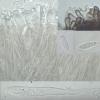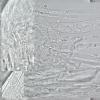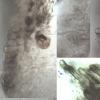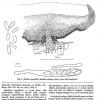
02-01-2026 17:43
MARICEL PATINOHi there, although I couldn't see the fruitbody, I

04-01-2026 17:45
 Stephen Martin Mifsud
Stephen Martin Mifsud
I was happy to find these orange asmocyetes which

03-01-2026 13:08
Niek SchrierHi all,We found groups of perithecia on a Lecanora

29-12-2025 17:44
Isabelle CharissouBonjour,J'aimerais savoir si d'autres personnes au

01-01-2026 18:35
Original loamy soil aside a artificial lake.The co

31-12-2025 19:27
Collected from loamy soil, at waterside (completel
Mollisia sp.
Uwe Lindemann,
17-10-2010 12:39
I recently found a Mollisia which I can’t determine. Therefore I hope that you can help me. Here some data:
macroscopical features:
Disc up to 1mm diam. Disc first blueish, later whitish; with a distinct black margin. Substrate: on a Fagus cupule
microscopical features:
Spores (9)11-13,5(15) x 4-5 µm
Asci with croziers, IKI+ (blue), KOH + IKI+ (blue),
Paraphyses without any visible content
Margin hairs brownish, without special features
KOH-reaction of the fruitbody negative, without a brownish Subhymenium
With the key of Andreas Gminder I come to M. sericeomarginata but I’m not sure…
Best,
Uwe
Hans-Otto Baral,
17-10-2010 12:44

Re:Mollisia sp.
Hi Uwe
could you please show us a section of the excipulum on flanks/margin? Also a photo of the paraphyses? Are they dead?
No idea presently
Zotto
could you please show us a section of the excipulum on flanks/margin? Also a photo of the paraphyses? Are they dead?
No idea presently
Zotto
Uwe Lindemann,
17-10-2010 16:19
Uwe Lindemann,
17-10-2010 16:21
Hans-Otto Baral,
17-10-2010 17:27

Re:Mollisia sp.
The paraphyses are alive and contain very low-refractive guttules, which further down get more refractive. The apical ring is Calycina-like. I do not see brown elements in the section. Why are these short brown hyphae of pic 1 not visible?
The hyaline excipulum does not look for me like a Mollisia. How is it toward base? Also hyaline? Also the paraphysis content is impossible for that genus. That looks more like a Pyrenopeziza. But I have no clear idea. I compare this with "Mollisia" spectabilis, but I do not have an image of that species and my 3 old specimens differ among each other. One has a Hymenoscyphus-type of apical ring.
Zotto
The hyaline excipulum does not look for me like a Mollisia. How is it toward base? Also hyaline? Also the paraphysis content is impossible for that genus. That looks more like a Pyrenopeziza. But I have no clear idea. I compare this with "Mollisia" spectabilis, but I do not have an image of that species and my 3 old specimens differ among each other. One has a Hymenoscyphus-type of apical ring.
Zotto
Uwe Lindemann,
17-10-2010 19:05
Uwe Lindemann,
17-10-2010 19:14
Re:Mollisia sp.
I forgot one thing: the "hairs" on the picture below in the middle are of the bottom of the fruitbody...
Hans-Otto Baral,
17-10-2010 19:25
Uwe Lindemann,
17-10-2010 23:47
Re:Mollisia sp.
Hi Zotto,
thanks for the description by Graddon. In fact, M. spectabilis seems to be very similar...
I tested also the reaction of the asci in MLZ and there is suprisingly only a weak reaction; some asci are also without any reaction. Concerning the diameter of the fruitbodies: most of my collection on the cupule are around 1mm as I wrote. But two of them are up to 2mm. This is fitting a little bit better to Graddons description.
Thanx a lot again for your help!
Uwe
thanks for the description by Graddon. In fact, M. spectabilis seems to be very similar...
I tested also the reaction of the asci in MLZ and there is suprisingly only a weak reaction; some asci are also without any reaction. Concerning the diameter of the fruitbodies: most of my collection on the cupule are around 1mm as I wrote. But two of them are up to 2mm. This is fitting a little bit better to Graddons description.
Thanx a lot again for your help!
Uwe
Tanja Böhning,
25-05-2013 16:39

Re : Mollisia sp.
Hallo,
Ist hier englisch üblich?
I think I found the same/similar species today on Fagus-Cupules. In the key of Andreas I got to sericeomarginata as well and in the key of Zotto I got to M. "spectabilis".
The spores are very broad, c.a. 11x4,5/5.
The Reaction (J) was very fade blue.
VG, Tanja
Ist hier englisch üblich?
I think I found the same/similar species today on Fagus-Cupules. In the key of Andreas I got to sericeomarginata as well and in the key of Zotto I got to M. "spectabilis".
The spores are very broad, c.a. 11x4,5/5.
The Reaction (J) was very fade blue.
VG, Tanja
Uwe Lindemann,
26-05-2013 15:13
Re : Mollisia sp.
Hallo Tanja,
es gab hier später noch einmal eine Diskussion zu dieser Spezies. http://www.ascofrance.fr/search_forum/20263?
Was sagt denn Andreas zu Deinem Fund?
Herzlich Uwe
es gab hier später noch einmal eine Diskussion zu dieser Spezies. http://www.ascofrance.fr/search_forum/20263?
Was sagt denn Andreas zu Deinem Fund?
Herzlich Uwe








